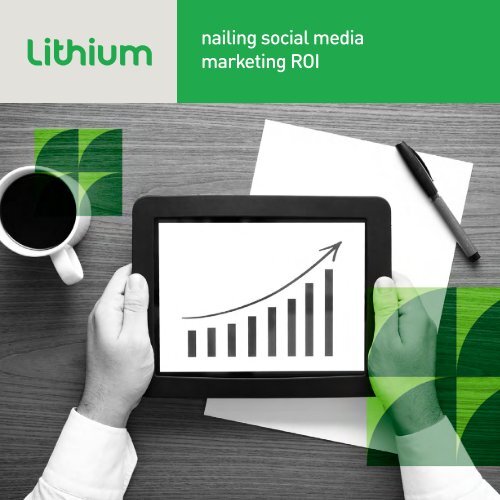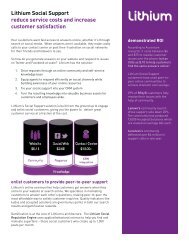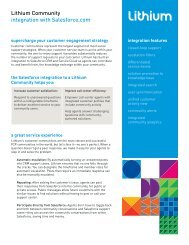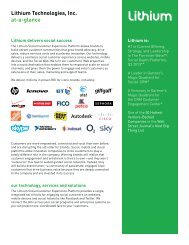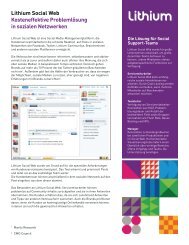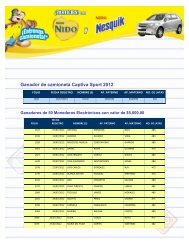Nailing Social Media Marketing ROI - Lithium
Nailing Social Media Marketing ROI - Lithium
Nailing Social Media Marketing ROI - Lithium
Create successful ePaper yourself
Turn your PDF publications into a flip-book with our unique Google optimized e-Paper software.
nailing social media<br />
marketing <strong>ROI</strong>
contents<br />
1 nailing it<br />
2 social media can be a scary place<br />
3 what social media marketing does right<br />
4 don’t confuse kpIs with business outcomes<br />
5 how to nail social media marketing <strong>ROI</strong><br />
6 start listening<br />
7 engage—build community<br />
9 operationalize<br />
10 extend the business value<br />
11 realize<br />
12 conclusion<br />
we help companies unlock the passion of their customers.<br />
The <strong>Lithium</strong> <strong>Social</strong> Customer Suite allows brands to build vibrant customer communities that:<br />
lithium.com | © 2012 <strong>Lithium</strong> Technologies, Inc. All Rights Reserved<br />
share this whitepaper<br />
2
nailing it<br />
While social does a lot of things right for marketers, we<br />
struggle to keep up with its constantly emerging nature and<br />
importantly, we need more and better ways to demonstrate<br />
<strong>ROI</strong> to the C-suite.<br />
42% of marketers say they are very concerned about demonstrating the value<br />
of social media to executive management—35% say improving social media<br />
measurement is a top priority. But just 4% of marketers say their ability to<br />
measure the overall impact of social media is excellent.<br />
A Google search of “social media marketing <strong>ROI</strong>” yields<br />
more than 4 million web pages spanning everything from<br />
marketing automation software to listening platforms to<br />
agency services. It’s clear that everybody and their brother<br />
wants to get in on the social media <strong>ROI</strong> game, yet marketers<br />
continually claim they haven’t got it figured out—yet.<br />
It certainly isn’t for lack of desire. Most marketers claim<br />
measurement is paramount, top of mind, a key priority—yet<br />
they end up giving themselves a C+ at best in their ability to<br />
pull it off. With 4 million web pages on the subject, with all<br />
the tools, technology and thought capital out there focused<br />
on this top of mind topic, why aren’t we all pulling straight<br />
As in the <strong>ROI</strong> department? What’s preventing social media<br />
marketers from walking tall with <strong>ROI</strong> pride?<br />
share this whitepaper<br />
1
social media can be<br />
a scary place<br />
The rate of change in the digital realm is in constant<br />
acceleration. New social apps and networks crop up<br />
overnight and it’s becoming increasingly difficult to tell<br />
a flash-in-the-pan fad from the next killer app. And we’d<br />
better get it right. If we don’t show up to the right parties our<br />
social currency plummets.<br />
Consumers don’t just expect us to be at all the right parties,<br />
they expect us to be there engaging them in specific ways.<br />
When our social customers like us on Facebook, 60% of<br />
them expect to find peer-to-peer experiences and 46% expect<br />
incentives or rewards. And with 40% of consumers saying<br />
they want more from brands in social media, we’ve got our<br />
work cut out for us.<br />
#boo<br />
share this whitepaper<br />
Indeed, the landscape is complex, crowded and demanding<br />
and we’re feeling it. 45% of marketers are very concerned<br />
about getting the right social media tools and technologies in<br />
place and 44% say they are very concerned about competing<br />
for attention in social media. Many more are fearful of dipping<br />
their toes into the social media whirlpool because they might<br />
find a gnarly mess of negative sentiment swirling around the<br />
social web over their brand or their products—and they have<br />
reason to be. Consumers grumble when they’re unhappy and<br />
social media makes it easy for them to spread the details of<br />
their dissatisfaction. A full 42% of consumers report they are<br />
more likely to share negative brand experiences because of<br />
social media.<br />
Despite the bumpy road that social can be, it’s important to<br />
remember that marketers who dare to tread are those that<br />
come out ahead in the end with social customers. Those who<br />
listen, engage, experiment, and importantly approach their<br />
social media marketing practices with business goals in<br />
mind, are those best able to take advantage of all the things<br />
social does right.<br />
2
what social<br />
media marketing<br />
does right<br />
One thing is certain, social media marketing is great at raising<br />
awareness. Consumer surveys provide ample evidence—26%<br />
report social media is among the top 3 ways they become<br />
aware of new brands and products, and 52% report they use<br />
social media expressly to connect with brands.<br />
Today’s marketers resoundingly agree that social media<br />
does a great job at the top of the funnel—75% say their social<br />
media efforts have generated brand exposure. And while<br />
brand exposure may be a squishy metric, unique visits to the<br />
website is not. 74% of marketers today say their investments<br />
in social media have increased web traffic—a key driver<br />
of SEO. Traffic volume and growth matter to the search<br />
algorithms that help our customers find us. The more traffic<br />
we have, the more likely our customers will be able to find us.<br />
And the more traffic we’ll have, and so on.<br />
Especially for marketers claiming difficulty with<br />
demonstrating quantifiable <strong>ROI</strong> to the C-suite, this is<br />
welcome news. Our social media efforts undeniably raise<br />
awareness and consumer data backs it up. It drives SEO,<br />
which can be benchmarked and shown to improve as we put<br />
our social media marketing initiatives to work.<br />
<strong>Social</strong> media also does a bang up job at deepening<br />
engagement. 72% consumers report that because of social<br />
media, they are more likely to stay engaged with brands.<br />
Not only does social do great for the top of the funnel, it also<br />
makes folks more likely to hang around, consider what we<br />
72%<br />
of of consumers are more likely to stay engaged with<br />
brands because of social media.<br />
share this whitepaper<br />
have to say, join the conversation, and check back again.<br />
Consumers like connecting with brands through social<br />
media because it’s a two-way street. They get to listen actively<br />
when and where they want to, interact with others like them,<br />
and be heard.<br />
Our social efforts raise awareness, deepen engagement,<br />
even help us to innovate—11% of marketers say they<br />
they’ve developed new products with the help of their social<br />
customers. Finally, consumers fully corroborate the value<br />
of social media for word of mouth marketing—80% report<br />
that they are more likely to try new things based on friends’<br />
suggestions because of social media.<br />
80%<br />
of consumers are more likely to try new things based on<br />
what friends suggest through social media<br />
Overall, we give the social media marketing channel pretty<br />
high marks. 35% of marketers say social media marketing<br />
helps to meet primary business objectives better than most<br />
other channels. So we all agree that even though it’s a bit<br />
scary, it does some things very well. Why do we struggle so<br />
with proving it?<br />
3
don’t confuse<br />
kpis with business<br />
outcomes<br />
The advent of social media has given us a whole new set of<br />
metrics to track. Fans, likes, followers, volume of mentions,<br />
sentiment, and share of voice just to name a few. But it’s<br />
important to note that these shouldn’t be the key objectives<br />
behind our social media marketing efforts. These are<br />
performance indicators—early signals of how well we might<br />
be driving business outcomes. They are a means to an end,<br />
but not the end itself.<br />
The end-game of our social efforts should be to drive real<br />
business outcomes—things like reducing the cost of support,<br />
increasing word of mouth marketing (WOMM), improving<br />
customer satisfaction, building brand advocacy, and driving<br />
revenue. <strong>Social</strong> media marketing <strong>ROI</strong> eludes us when we’re<br />
too busy measuring KPIs and not busy enough putting<br />
business objectives at the core of our efforts.<br />
share this whitepaper<br />
4
how to nail<br />
social media<br />
marketing ROi<br />
The art of getting to real and quantifiable social media<br />
marketing <strong>ROI</strong> means driving your social practice toward<br />
maturity. Only then can we realize the full benefits of<br />
connecting with our customers through social media.<br />
Maturity happens when we do four things very well:<br />
1. Listen to our social customers<br />
2. Engage them with purpose<br />
3. Operationalize our business<br />
around the social customer, and<br />
4. Extend the business value of our<br />
social interactions.<br />
Only then will we realize the full benefit of social<br />
media marketing—quantifyable <strong>ROI</strong>.<br />
share this whitepaper<br />
5
start listening<br />
26% of consumers say they connect with brands on Facebook<br />
because they want to be heard. 25% say that when they<br />
Tweet about a brand or product—good or bad—they expect<br />
to hear from the company. And we’re letting them down. 9%<br />
of consumers report that they’ve actually heard from a brand<br />
after Tweeting about them.<br />
It’s no wonder. A surprising 72% of marketers say they’ve not<br />
used a paid buzz-monitoring service. With 34% of consumers<br />
claiming their opinions about brands are shaped by what<br />
is said about them in social media, social media marketers<br />
simply can’t afford not to be listening. Consumers clearly are,<br />
and brands must be too.<br />
Listening to what our customers have to say about us is a<br />
fundamental component of getting to social media marketing<br />
<strong>ROI</strong> because it allows us to identify and develop relationships<br />
with our key advocates and influencers and it gives us an<br />
immediate benchmarking capability. Especially for marketers<br />
looking to demonstrate social <strong>ROI</strong>, social media monitoring is<br />
a must have. Listening platforms bring a wealth of customer<br />
and market intelligence to the fore—volume of mentions,<br />
sentiment, emerging topics and competitive data all culled<br />
from millions of blogs, forums, news sites and social<br />
networks. Each data point can be benchmarked and tracked<br />
for positive lift as social media initiatives are put in market.<br />
share this whitepaper<br />
Listening is the first step in developing a solid set of KPIs that<br />
can be used to measure business performance. When we<br />
track how well our campaigns and new product introductions<br />
create buzz and excitement with our social customers—and<br />
we see how all that activity increases our share of voice<br />
across social media, we are on track for driving a real<br />
business objective: competitive advantage.<br />
social kpi business outcome<br />
# mentions<br />
positive sentiment<br />
share voice<br />
competitive advantage<br />
6
engage—build<br />
community<br />
Only social customers who are truly engaged with your brand<br />
can help you drive business objectives. Barely 3% marketers<br />
report that when fans like their brand on Facebook, it results<br />
in better quality interactions. Why?<br />
We must ask ourselves if our Facebook fans are truly<br />
engaged. If they’ve landed on our page and there’s nothing<br />
for them to do, if they can’t get help or talk directly to other<br />
customers, share ideas, or contribute content, how engaged<br />
can they possibly be?<br />
If you’re among the 54% of marketers who say customer<br />
engagement is the most important measure of marketing<br />
effectiveness, think online community. Customer<br />
communities are places where brands can deliver social<br />
customer experiences that deepen engagement in a number<br />
of measureable ways and drive real business outcomes in<br />
the process—like increased revenue. Sephora community<br />
Superfans—their most passionately engaged social<br />
customers—spend over 10x that of their average customer.<br />
social kpi business outcome<br />
# superfans increased revenue<br />
Marketers get the idea of community in an intuitive sense.<br />
74% say creating community around the brand is a social<br />
media business objective. But only 18% of marketers say their<br />
business has an online community. To start driving real <strong>ROI</strong><br />
18%<br />
share this whitepaper<br />
onine communities increase loyalty, deepen engagement<br />
and drive SEO. Only 18% of marketers say they have one.<br />
from social media, we must make the leap from talking about<br />
the concept of community to actually building one.<br />
Online communities are vibrant customer networks where<br />
marketers motivate consumers to do things that are great<br />
for each other and great for the brand. <strong>Social</strong> engagement<br />
apps like blogs and forums, polls and contests, and the ability<br />
for our social customers to achieve rank and reputation<br />
within our customer community help us to better engage<br />
our customers, satisfy them and keep them loyal. Giffgaff, a<br />
modest UK-based telecom provider whose online community<br />
is responsible for 100% of customer support, enjoys a Net<br />
Promoter score in the 70s—on par with global brands like<br />
Google and Apple.<br />
social kpi business outcome<br />
# community provided<br />
support solutions<br />
increased NPS<br />
7
If you’re among of the 90% of marketers who say brand<br />
awareness is a social media objective, or the 78% who<br />
say driving visitors to your brand website is a social media<br />
objective, your brand should have or be making plans for<br />
an online community. Online communities build awareness<br />
and drive web traffic amazingly well. HP Consumer Support<br />
Forums have generated over 500 million page views<br />
across 7 languages.<br />
70% of consumers say Internet search is among the top<br />
3 ways they become aware of new brands and products.<br />
Online communities build relevant content quickly, boosting<br />
web pages to the top of search results, driving significant<br />
awareness in arguably one of today’s most important<br />
communication channels.<br />
share this whitepaper<br />
social kpi business outcome<br />
increased page views<br />
increased brand<br />
awareness<br />
8
operationalize<br />
Pulling social customers into the function, not just as another<br />
cell in the matrix, but as an organizing principle, makes great<br />
things happen for the customer and the brand. Those brands<br />
that are leaping ahead are making social the way they do<br />
business by operationalizing their social media marketing<br />
practices. They have the policies, processes, and technologies<br />
in place to make social customers and their experiences the<br />
heart of the business. When we operationalize our social<br />
media marketing efforts, we move from earned media to<br />
owned media. Only then can we share social customer<br />
data, insights, and decision-making across the entire<br />
organization—service & support, marketing, sales, PR, and<br />
operations—fully optimizing the critical business asset that is<br />
the social customer.<br />
Leading-edge social brands are coordinating initiatives<br />
in cross-functional teams as they adopt a more holistic<br />
approach to social media. Not only do they deliver better<br />
customer experiences, they also enjoy more streamlined<br />
internal operations and reduced costs.<br />
To gain insight into customer decision-making, build<br />
brand advocacy, drive innovation and generate sales leads<br />
from social media, we must maximize the business value<br />
of all social customer interactions. Only when we fully<br />
operationalize our social efforts do we begin to leverage<br />
social media Swiss army-style—in every way we can,<br />
across the entire business.<br />
share this whitepaper<br />
The 38% of marketers who say integrating social media with<br />
other channels is a top priority are on the right path. Our<br />
social efforts impact SEO, drive attendance at corporate<br />
events, and amplify our PR efforts. Integrating social across<br />
all these channels is part of operationalizing our social media<br />
marketing practice and crucial to nailing <strong>ROI</strong>. When our<br />
efforts are evaluated for their ability to drive real business<br />
outcomes across the entire organization, the <strong>ROI</strong> story<br />
becomes much easier to tell and delivers far greater impact.<br />
58%<br />
of consumers say the last time they connected with a<br />
brand on Facebook, nothing happened.<br />
9
extend the<br />
business value<br />
Although our absence from Facebook may not seem like a big<br />
deal, it does make us conspicuous. 86% of marketers say they<br />
actively use Facebook in their marketing efforts. Point of fact:<br />
Consumers expect to find us there.<br />
But even those marketers who claim to “actively use”<br />
Facebook in their marketing efforts may be overestimating<br />
their social prowess. Are they really “actively” there, or just<br />
there? A full 58% of consumers report that the last time they<br />
connected with a brand on Facebook, nothing happened. No<br />
thank you message, no additional offers, no solicitation of<br />
feedback, nothing.<br />
Very crucial to driving <strong>ROI</strong> from social channels like Facebook<br />
is not just to be there, but to be there with purpose. When<br />
we extend community to social networks like Facebook—<br />
we extend the business value by bringing our community<br />
engagement capabilities with us. Now we’re on Facebook<br />
offering something useful to our fans—product information, a<br />
chance to interact with other customers, a way to share ideas,<br />
to be recognized and earn rewards.<br />
To extend the business value of our social investments, once<br />
again, the reasons we’re on Facebook should have everything<br />
to do with our business objectives—increasing customer<br />
satisfaction and loyalty, for instance. Since Sky extended their<br />
help forums to Facebook and Twitter, customers report 90-<br />
100% satisfaction.<br />
share this whitepaper<br />
social kpi business outcome<br />
# problems solved<br />
through community on<br />
Facebook<br />
increased satisfaction<br />
Driving product innovation with social customer input is<br />
another way to extend the business value of our social<br />
initiatives. Verizon has implemented over 30 of the 1700 ideas<br />
surfaced through community.<br />
social kpi business outcome<br />
ideas submitted through<br />
Facebook<br />
increased satisfaction<br />
Interacting with our social customers online yields enormous<br />
data about consumer behavior—if we have the right tools in<br />
place to capture and analyze it. While consumer interactions<br />
on Facebook are extremely data rich, 62% of marketers say<br />
they have not used Facebook user data to build customer<br />
intelligence. The truth is, Facebook offers marketers very<br />
little information about the social customers who connect<br />
with them through the network. Unless we build community<br />
and extend it to social networks like Facebook, we’re missing<br />
out on the full business value of social—the ability to gather<br />
actionable intelligence about our social customers.<br />
10
ealize<br />
42% of marketers say that brand awareness/recognition<br />
is quite important to their business—only 5% say they are<br />
able to measure it very well. 37% say that <strong>ROI</strong> is important,<br />
while only 6% say they are able to measure social media <strong>ROI</strong><br />
well. 31% say that customer retention is quite important, but<br />
only 5% of marketers say they able to measure customer<br />
satisfaction extremely well.<br />
Without the ability to benchmark, measure and demonstrate<br />
lift across key social media performance data, without the<br />
ability to show a direct correlation between social media<br />
KPIs and key business objectives, your social media practice<br />
is vulnerable. Developing a mature <strong>ROI</strong> model is every bit<br />
as important to realizing the full benefit of social media<br />
marketing as is having a social media strategist on board.<br />
<strong>Nailing</strong> social media marketing <strong>ROI</strong> is as least as important<br />
as having a Facebook page or a Twitter account, and way<br />
more important than keeping up with the latest social media<br />
shiny object like Foursquare or Pinterest.<br />
share this whitepaper<br />
11
conclusion<br />
<strong>Nailing</strong> social media marketing ROi means<br />
tackling a few key things:<br />
Face your social fears.<br />
Yes, social media can be scary. It’s a constantly emerging<br />
landscape where the customer is in charge of the<br />
conversation. But we mustn’t let its daunting nature deter<br />
us. Smart marketers are simply swallowing the jagged pill,<br />
relinquishing control of the relationship, actively listening to<br />
what social customers actually say about them, and engaging<br />
them on their terms. Smart marketers embrace new tools<br />
and technologies and meet social customers where they<br />
live—whether it’s on Facebook or a smart phone. And if<br />
they get it wrong the first time out of the gate—no worries.<br />
With a test-learn, fail faster mentality, today’s leading-edge<br />
marketers are keeping up with the pace of their social<br />
customers and blazing new trails for the entire business.<br />
Benchmark.<br />
<strong>Social</strong> media marketing is all about moving the needle. Before<br />
any sinitiative is put in play, it’s important to know where<br />
the needle is. Survey customers to determine Net Promoter<br />
Scores before and after social initiatives are launched.<br />
lithium.com | © 2012 <strong>Lithium</strong> Technologies, Inc. All Rights Reserved<br />
share this whitepaper<br />
Check in with your SEO team and benchmark unique visits,<br />
tap the sales team for current lead flow and see how these<br />
metrics improve once your social campaign hits the streets.<br />
If you don’t have a method for measuring revenue from social<br />
channels, get one.<br />
Track social KPIs, measure social success against<br />
business outcomes.<br />
Your business cares about customer satisfaction and loyalty,<br />
brand awareness and revenue, not fans and followers. Keep<br />
an eye on social KPIs like a doctor would on the patient’s body<br />
temperature and pulse. Think of them as vital signs, signals<br />
of what might be happening at a deeper level, but don’t let<br />
them overshadow what should be your real concern—the<br />
overall health of the business. Use real business objectives<br />
as benchmarks for your social strategy, experiment, refine,<br />
measure again. Now you’re on your way to nailing social<br />
media marketing <strong>ROI</strong>—measuring real business change.<br />
resources<br />
1. Getting to <strong>Social</strong> Business Advantage in 2012. <strong>Lithium</strong>, CMO Council 2011<br />
2. 2012 State of <strong>Social</strong> <strong>Media</strong> <strong>Marketing</strong>—<strong>Social</strong> <strong>Media</strong> Measurement, Objectives<br />
and Budget Implications. <strong>Lithium</strong>, <strong>Marketing</strong>Profs 2012<br />
3. <strong>Lithium</strong>, Red Shift <strong>Media</strong> Survey of 1,000 + consumers on use of social media.<br />
<strong>Lithium</strong> social solutions helps the world’s most iconic brands to build brand nations—vibrant online communities of passionate social customers.<br />
<strong>Lithium</strong> helps top brands such as AT&T, Sephora, Univision, and PayPal build active online communities that turn customer passion into social<br />
media marketing <strong>ROI</strong>. For more information on how to create lasting competitive advantage with the social customer experience,<br />
visit lithium.com, or connect with us on Twitter, Facebook and our own brand nation – the Lithosphere.<br />
12


